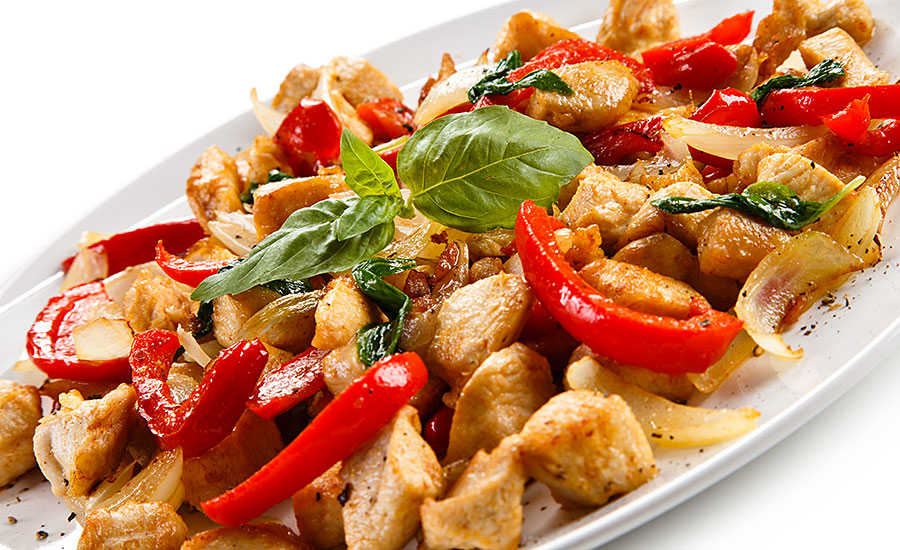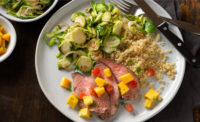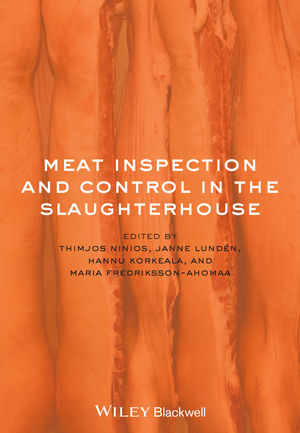Producing and merchandising meat and poultry in sizes that meet consumers’ sharper focus on health and sustainability is becoming more prevalent.
The ability to easily limit the number of calories and amounts of fats, sodium and other elements in their diet and buy proteins that correspond with household size is making portion control increasingly important to shoppers and becoming a significant merchandising tool for retailers and processors.
“American consumers regard portion control as an important component of dieting and maintaining an ideal weight,” says Tom Vierhile, vice president of strategic insights, North America, for Innova Market Insights, an Arnhem, Netherlands-based market research firm focusing on the global fast-moving consumer goods and food and beverage sectors.
In the March 2019 Innova Diet Trends online survey of 1,000 U.S. consumers, 33.6 indicated a focus on portion size has been a contributor to their decline in red meat consumption over the past year, and that just 19.2 percent of respondents admitted to an increase in red meat consumption.
In addition, 34.7 percent of respondents reported they increased consumption of poultry, which has a greater health halo then red meat, while 14.9 said that they decreased their poultry consumption, Innova reports.
“The numbers indicate that red meat is somewhat more likely to see consumption decreases as a result of a change in eating habits or diet, which is probably not a huge surprise given the negativity surrounding consumption of red meat,” Vierhile says.
Because 59.2 percent of consumers also indicated they would rather have a small portion of a “really indulgent” product than a “diet” item, such shoppers would likely be receptive to portion control as long as they are not sacrificing quality, he says.
“This provides an avenue for innovation for animal protein marketers as consumers seem more likely to swallow the ‘less is more’ concept if it is delivered in a high-quality presentation,” Vierhile says.
Abundant possibilities
In addition to marketing meat and poultry in specific sizes, merchandisers can offer some portion control to consumers through the use of resealable product packaging, he says.
The availability of meat and poultry in single-use packaging also can support portion control, Vierhile says, but adds there is little growth in the accessibility of such products.
Also slowing the expansion of portion control is a lack of focus in the area by suppliers of some meat and poultry accoutrements, Vierhile says. Examples include those that produce hamburger and hot dog buns, which typically are just available in eight-bun packages.
“That is not a great number for individuals in one- or two-person households that just want a hamburger or two over the course of a week, particularly because there is going to be a lot left over and could result in waste,” he says, adding that meats that are individually wrapped for freshness are more apt to attract the portion-control shopper.
Other portion-control vehicles include vacuum packaging, which enables consumers to cut a package of meat in half and use one side immediately while freezing the other for later consumption, Vierhile says.
“Many one- and two-person households are not interested in buying large quantities and the share of singles may be as high as 40 percent in some parts of the country, such as in Manhattan and downtown Chicago,” says Anne-Marie Roerink, principal of 210 Analytics, a San Antonio-based market research and marketing strategies firm.
A greater consumer focus on moderation also is increasing interest in portion control, she says, with more shoppers positioning meat and poultry as a meal ingredient instead of a center-of-the-plate item, and also gravitating to flexitarian eating, in which people primarily follow a vegetarian diet but occasionally consume meat or fish.
“While bigger packages drive volume, some shoppers may actually skip the purchase because they cannot find the amount they are looking for,” Roerink says. She notes that portion-control cuts are more prevalent in Europe where many of the common SKUs, such as chicken breast, are available in single-, two-, four- and volume discount packs, and value-added pre-cut or pre-marinated options also come in a wide variety of sizes.
Operational obstacles

Processors and retailers are finding that it can be tough to successfully produce and merchandise meat and poultry that meet portion-control standards.
“All segments of the food industry portion beef in some manner,” says Laura Hinton, director of retail engagement at the Centennial, Colo.-based National Cattlemen’s Beef Association (NCBA), a contractor to the Beef Checkoff. “But it can be costly and labor intensive to pre-portion to a specific size and hit an exact weight each time at the store level. As such, we’ve seen some retailers utilize packer partners to bring individually packaged, exact-weight servings to the case.”
Cost-cutting and labor shortages are making it challenging for grocery and foodservice operators to develop products in house that meet the specifications for portion control, says Maeve Webster, president of Menu Matters, an Arlington, Vt.-based food industry consulting firm.
“It makes it more difficult for the parties to create the best sizes for their patrons and menus,” Webster says. “That limits them to only what their vendors and purveyors are offering and the challenge will be in the variety of portion control and smaller sizes that are available.”
Because of the development of increasingly larger animals, it is becoming more burdensome to create smaller portions because of higher labor and technology expenses, says Jonathan Valdez, owner and founder of Genki Nutrition, a New York-based health and wellness firm. Valdez also is spokesperson for the New York State Academy of Nutrition and Dietetics.
“Dealing with animals is not a uniform business,” he says. “They come in all shapes and sizes and often differ in size depending on the season, which makes it increasingly difficult to produce a consistent set-weight product.”
Valdez adds, however, that there will likely be enhancements to processing equipment for portion control to make the technologies less expensive and easier to clean.
Even with technological upgrades, which may include more intelligent robotic technologies, there is unlikely to be any major breakthroughs that change the dynamics of the sector, says Tom Super, senior vice president of the Washington, D.C.-based National Chicken Council (NCC).
A complicated merchandising maze
In some respects, it can be more difficult to market portion-controlled items because proteins cut in uniform sizes are often not as visually appealing in the meat case as different sized items, Super says that random size displays usually appear more natural and fresher.
Environmental factors also can limit shopper interest in products, Super says.
“Portions uniformly packed tend to have more packaging associated with the product and more durable containers,” he says. “With rising consumer concerns about packaging, and especially plastic, recycling issues and adding to the environment can be in the forefront with certain portion-control products.”
A recent National Chicken Council consumer survey reveals rising shopper interest in sustainability and while Super says most of that concern focuses on the product itself, “it seems evident that sustainability will more and more encompass the issue of packaging. Consumers will be judging the entire bundle of product and how it is packaged relative to being more sustainable.”
Facing the same packaging costs while selling less meat and poultry is another potential drawback for retailers merchandising smaller portion sizes, says Anne-Marie Roerink, president of 210 Analytics, a San Antonio-based market research and marketing strategies firm.
“It’s a mindset change and a risk that retailers have to be willing to explore,” she says. “There is a natural fear that if you offer smaller packages, everyone is going to move to buying small and you take a big hit in volume and dollars.”
Because of limited meat case space, retailers also must find ways to efficiently merchandise different package sizes while keeping an eye on restocking throughout the day, Roerink says.
Operators, meanwhile, can gage shopper interest in portion control by running limited tests in urban areas to see if smaller packages are moving and the impact to overall meat-case volume, she says.
“Such initiatives have to be a win-win — something the consumer appreciates, but that doesn’t go against the sales and profits of the retailer,” she says.
— Richard Mitchell
Shake off the traditional mindset
Offering meat and poultry in package sizes that cater to the needs of smaller households is especially important as such households encompass a wide range of shopper segments, including Baby Boomers who are empty nesters, Millennials who have not yet started families and young adults in their 20s, says Tara Dugan, director of consumer and marketplace insights for the Des Moines-based National Pork Board (NPB).
“Small and solo dining is prevalent in the U.S. and there is a need for more approachable-size pork options in the meat case,” she says. “Larger cuts of pork can intimidate younger shoppers in stores, particularly when they are unfamiliar with how to prepare the selections. Not only do approachable size options take some of the intimidation factor out of purchasing pork, but the items also can be easier to cook.”
Portion-control solutions can include pork chops in packages of four or six instead of 10 and merchandising wide arrays of selections in specific sizes, such as value-added meats that are pre-seasoned, pre-marinated or pre-cut, along with tenderloin strips, ham steaks and other convenience-oriented options, Dugan says.
A key factor limiting the widespread rollout of meat and poultry in portion-control sizes, however, is retailers’ and processors’ fear of the unknown, she says.
“Because things have been done the same way for so long, there might be resistance to change,” Dugan says. “But it is important to lean into what is happening in consumers’ lives in order to meet their evolving needs.”
To accentuate portion control, merchandisers should educate their supply chain partners on consumers’ changing habits and the importance of responding with the appropriate meat department selections, Dugan says.
“Shoppers have so many food choices available, including prepared and frozen options, so it is crucial that products in the meat case match their demands, otherwise they will purchase from other departments,” she says. “It also is essential that foodservice operators are versatile in the size of cuts available on menus.”
Research from the Centennial, Colo.-based National Cattlemen’s Beef Association (NCBA), a contractor to the Beef Checkoff, also reveals that pre-portioned individual-serving beef packages with nutrition-forward claims generate strong appeal across all consumer groups, says Caitlin Mondelli, NCBA director of food and health communication.
“Consumers indicate that this concept is likely to be incremental to current beef purchases while improving beef health perceptions, which is an advantageous opportunity for retailers,” she says. Consumers who are able to buy beef in different portion sizes can more easily plan meals in advance by freezing selections for later use, Mondelli says.
A wallop from the wellness crowd
“Portion control and specific portion sizes are now either a specific requirement for consumers or an underlying trend for many of the key product innovations hitting nearly all categories in both retail and foodservice,” says Maeve Webster, president of Menu Matters, an Arlington, Vt.-based food industry consulting firm.
The availability of meat and poultry in specific sizes makes it easier for consumers to purchase amounts that support their interest in weight control, healthier overall eating and even specific recipes, she says.
“Virtually all types of meat and poultry can accentuate portion control as long as the cuts are handled correctly, packaged appropriately and cut specifically,” Webster says. “That includes new cuts and value-added solutions, such as meat cubes and strips.”
Among the health-conscious shoppers who are active buyers of portion-control selections are people who need to limit protein intake because of health issues and consumers who want smaller amounts of meat and poultry because they follow a more flexitarian diet, says Jonathan Valdez, owner and founder of Genki Nutrition, a New York-based health and wellness firm and spokesperson for the New York State Academy of Nutrition and Dietetics.
“Portion control is one of the simplest yet effective ways to combat weight gain which can lead to obesity,” he says. “Offering meat and poultry in specific sizes makes it much easier for the shopper to consume an appropriate amount of food during meals.”
In addition to the health aspects, portion control is attractive to consumers want to reduce food waste, says Caroline West Passerrello, former dietician for Pittsburgh-based supermarket operator Giant Eagle and spokesperson for the Chicago-based Academy of Nutrition and Dietetics, an organization of food and nutrition professionals.
She says that because the price per pound for pre-portioned cuts is often higher because of the added labor and packaging, the most active purchasers usually have more disposable income. She adds it is important for retailers to make it easy for the shoppers to locate selections.
“Portion-controlled merchandising varies by retailer and store demographics,” Passerrello says. “Customers should be educated to look in both the meat case and the frozen section for a portioned product and to speak with their store leaders to voice their requests.”
To further emphasize portion control, grocers with service meat counters can advertise they will cut customers’ choices according to their specifications and offer information on recommended portion sizes at the meat counter or on their websites, she says.
“Retailers offering portion-controlled cuts of meat will also want to partner with their in-store dietitian or community dietitians to promote it so that the target customer is reached,” Passerrello says.
All about the individual
Consumer research is revealing strong shopper interest in the availability of meat and poultry in specific sizes.
In a June 2017 online survey commissioned by the Centennial, Colo.-based National Cattlemen’s Beef Association (NCBA), a contractor to the Beef Checkoff, 70 percent of respondents indicated they definitely or probably buy beef packages in individually portioned servings.
In addition, 66 percent agree completely or somewhat that such products are high quality, and 59 percent agree completely or somewhat they would be interested in knowing more about the products.
Thirty-six percent of respondents, however, indicated they agree somewhat or completely that the product looks too expensive for them.
When buying meat, 38 percent of consumers stated they would consider individually portioned beef packages on some shopping trips; 24 percent on most shopping trips; 21 percent on all shopping trips; and 18 percent reported they would not consider the products.
The 1,059 survey respondents were aged 18 to 71, eat beef more than once a month and are responsible for at least half of their household’s food purchasing and cooking.
A study for the Power of Meat 2018 report, meanwhile, found 72 percent of shoppers would want to see a variety of package sizes for portion control. That includes 74 percent of young Millennials, 75 percent of older Millennials, 72 percent of Generation Xers and 70 percent of Baby Boomers.
“This is the most popular health- and wellness-focused feature and is endorsed across generations, incomes and areas,” the report says, noting that other desirable packaging elements include dietary callouts and information on the amount of protein, calories, sodium and fat in the meat and poultry.
The Power of Meat 2018 is published by the Arlington, Va.-based Food Marketing Institute and the Washington, D.C.-based Foundation for Meat and Poultry Research and Education and prepared by San Antonio-based 210 Analytics, a market research and marketing strategies firm.
Keep the ball rolling
“Many consumers are not looking to eliminate meat and poultry from their diet, but do believe in portion control and limiting second helpings,” says Anne-Marie Roerink, 210 Analytics principal. “By providing a way to do that, we can ensure that they keep meat on the plate instead of exploring different options they deem healthful as well, which may be plant-based meat alternatives and such other sources of protein as seafood and eggs.”
The call for package size variety is “becoming louder as the years roll by,” she says, adding that merchandisers who offer smaller portions can still generate larger sales rings.
“Quite a few retailers already are offering chicken breast that are individually packaged in vacuum-sealed packages within a larger bag,” Roerink says. “Those are a definite win-win for the industry and consumers, particularly as the packaging is freezer-ready.”
U.S. retailers, meanwhile, can also follow the lead of some European operators by offering mix-and-match promotions, which enable shoppers to purchase a specific number of smaller portion-size packages of items such as kabobs, burgers, chicken, pork and vegetarian selections for a set price, Roerink says.
“There are variations of this in the U.S, but the focus still is often on large quantities,” she says. “But the idea of benefitting from a variety of meat choices within a promotional model fits right into the idea of smaller portions.”
— Richard Mitchell
Make it worth the price
Along with wellness and environmental benefits, portion control also makes food preparation easier and more efficient for consumers, says Tom Super, senior vice president of the Washington, D.C.-based National Chicken Council.
“Not only does portion control greatly help in managing food costs and standardizing cooking times, it also eliminates consumer complaints that my table partner’s piece of chicken is bigger than mine,” he says.
While breast meat has traditionally been the most prevalent portion-controlled chicken selection, the increasing acceptance and use of boneless/skinless thigh meat suggests more back-of-the-bird meat will appear in portion-controlled presentations, Super says.
“Portion-control chicken products will continue to become more popular, especially if marketers can more fully and successfully address consumer concerns about the product being natural and having environmentally friendly packaging,” he says. “Educating consumers to better understand the benefits and features of portion-control products will help make the price points for these items more attractive to the shoppers.”
He says that while portion-control products tend to cost more per pound than random weight and sizes, the cost/benefit equation tilts heavily toward portion-control items, “especially where the back of the house lacks skilled and experienced food preparers and cooks.”
“Portion control is incredibly important and companies are getting much better at it,” says Keith Belk, a professor and head of the Department of Animal Sciences and the Center for Meat Safety and Quality at Colorado State University, in Fort Collins. “It is almost a necessity today for processors to cut specific portions from different types and sizes of meats.”
Belk says because of a shortage of meat and poultry plant workers, cutting is becoming increasingly automated, with greater use of robotics, water jet cutting, spiral slicing and video imaging systems that use X-rays to map out cuts before portioning, which minimizes waste and greatly increases productivity. “This equipment puts a dent in the problem of companies not having enough employees,” he says.
A potentially powerful payback
Processors that use technologies for portion control are often able to quickly recoup the cost of the equipment because of less waste, Belk says.
“It doesn’t take too many pork loins over 365 days to pay for a pretty expensive system if you pick up even a tiny amount of yield each time there is cutting,” he says.
The availability of cuts in specific sizes also can more easily enable retailers to prepare the expanding array of meal kits in stores, Super says, noting that more shoppers will likely be willing to pay extra for items such as marinades that simplify at-home preparation.
Stores without fresh-meat counters or in-house butchers are especially attractive locations for portion-control options, Roerink says. She says chicken breast and pre-formed burgers in one-, two- or four-count packages can accommodate different household sizes and be strong sales drivers.
“There is a trend in retail toward smaller basket sizes and purchases that are often for specific occasions, so some customers are looking for specific portions of meat that are ideal for a single occasion,” says Charles Winship, senior research analyst for Technomic, a Chicago-based food industry research and consulting firm. “In addition, shifts in overall eating behavior (are) impacting meal size. Some consumers are looking for larger portions to hold off hunger as they skip meals, while others are seeking high-protein snacks.” NP








Report Abusive Comment